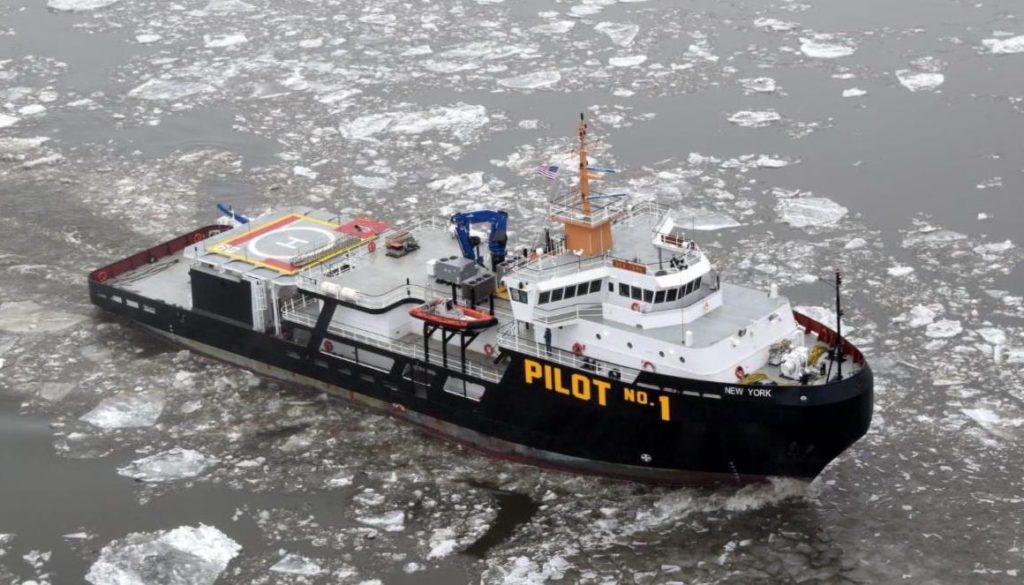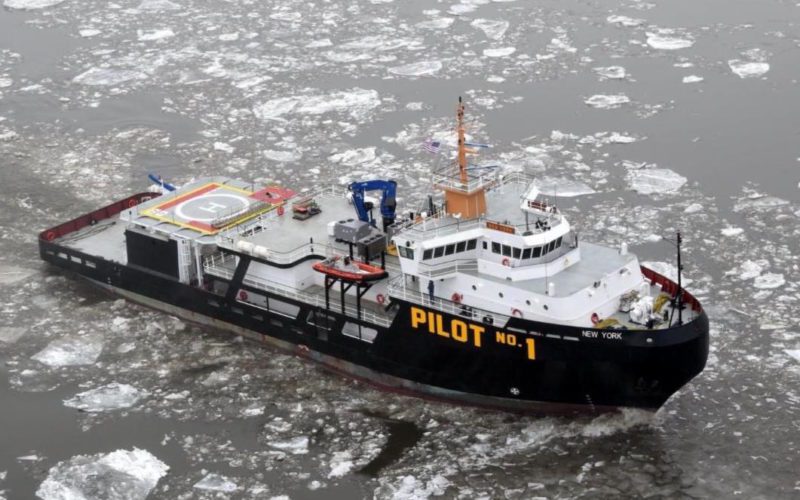(STATEN ISLAND, N.Y.) — This month, the Sandy Hook Pilots Association welcomed its new pilot station boat New York, a converted oil spill response vessel (OSRV), which, at 208 feet long, is the largest in the pilots’ fleet.
In addition to welcoming its new one-of-a-kind vessel, the Sandy Hook Pilots retired its predecessor, also named New York, with a hearty “well done.” A symbol of safety and heroism, the now-retired New York, a familiar sight in the Port of New York and New Jersey harbor for nearly 50 years, made its last transit up the Ambrose Channel from the pilot station on Feb. 2.
On Feb. 3, the new New York sailed to its new home, the Sandy Hook Pilots base in Staten Island, situated alongside its predecessor, the old New York, launching a new era of safety and efficiency for the New York/New Jersey harbor.

Once the OSRV Maine Responder, the new craft was made available by the Marine Spill Response Corp. after years of searching by the Sandy Hook Pilots for the right vessel to replace the aging New York. A full study of the OSRV was conducted with surveys of the entire vessel, including sea trials of a sister vessel on pilot station to compare seakeeping and ship-handling capabilities to the present station boats.
End of an era
The now-retired New York was always “on station” for pilots, whose guidance and safe navigation skills have a long tradition upon which the maritime industry stakeholders within the port have come to depend.
The vessel proudly served New York/New Jersey Harbor as a prominent fixture that ships calling on the bi-state port could always find reliable. But in addition to its traditional duties, the boat, built in 1972 and designed by M. Rosenblatt & Sons, served multiple roles and many pilots active and retired spent countless hours aboard training as apprentices.
Over the past 50 years, the vessel assumed vital roles during some of the worst days in the history of this country, including the Sept. 11 terrorist attacks in 2001. For two weeks, New York served as the main command center for public agencies such as the U.S. Coast Guard, the New York Police Department, the Fire Department of New York, the FBI and first responders.
“The retired New York was part of the Sandy Hook Pilots family for nearly five decades. It served us well and helped our members demonstrate our commitment to support the port in every way possible,” said Capt. John DeCruz, president, United New York Sandy Hook Pilots Association. “Looking to the future, the new state-of-the-art New York reflects how the association will serve the harbor for the next 50 years — with enhanced safety, productivity and efficiency.”
Welcoming the future
The new New York has big berths to fill. JMS Naval Architects in Mystic, Conn., was hired to survey the OSRV and assist the Sandy Hook Pilots in the conversion project of the vessel into a station boat. The completed version includes a new deckhouse for pilot berthing and facilities with enhancements to the existing house and superstructure.
The conversion project was conducted in three phases. Phase one took place at Caddell Dry Dock and Ship Repair of Staten Island. It consisted of a hull inspection, dropped rudders, shaft inspection and a complete modification of the stern, readjustment of mast and observation tower, and developing of anchor pockets. There was also an initial inspection and project approvals from the American Bureau of Shipping and the Coast Guard.
The final two phases were completed at Feeney’s Enterprises situated in Kingston, N.Y. Two main projects that Feeney’s had to complete before seasonal weather changes were the tear-outs of the vessel’s oil/water recovery system on deck and in the holds. New potable water tanks were fabricated to allow the vessel to keep stationed up to six weeks before returning for fuel and water. One major addition was the construction of a two-deck house that sleeps up to 28 pilots, with a pilots’ lounge and mess hall. The bridge wings were extended to give a clear view of the pilot launch landing area on each side of the vessel, with CCTV camera system installed throughout the vessel’s interior and exterior spaces.
Since the introduction of the new New York in early February, the entire crew of apprentice pilots and permanent union crew (International Organization of Masters, Mates & Pilots, ILA, AFL-CIO-AMG Division) have been familiarizing themselves with the vessel and participating in training conducted by Maritime Pilots Institute (MPI) of Covington, La.
– Sandy Hook Pilots Association

